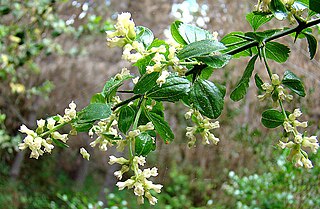
Xylosma is a genus of flowering plants in the family Salicaceae. It contains around 100 species of evergreen shrubs and trees commonly known as brushhollies, xylosmas, or, more ambiguously, "logwoods". The generic name is derived from the Greek words ξύλον (xylon), meaning "wood, tree", and ὀσμή (osmé), meaning "smell", referring to the fragrant wood of some of the species. The Takhtajan system places it in the family Flacourtiaceae, which is considered defunct by the Angiosperm Phylogeny Group.

Azorella is a genus of flowering plants in the family Apiaceae, native to South America, New Zealand, southeastern Australia, and the islands of the Southern Ocean.

Escalloniaceae is a family of flowering plants consisting of about 130 species in eight genera. In the APG II system it is one of eight families in the euasterids II clade (campanulids) that are unplaced as to order. More recent research has provided evidence that two of those families, Eremosynaceae and Tribelaceae, arose from within Escalloniaceae; the Angiosperm Phylogeny Website therefore merges these two families into Escalloniaceae, and also places the family alone in order Escalloniales.

Colletia is a genus of flowering plants in the family Rhamnaceae, with five species of spiny shrubs. All species of this genus are native to southern South America. They are non-legume nitrogen fixers.

Salpiglossis is a genus of flowering plants belonging to the subfamily Cestroideae of family Solanaceae. It is closely related to the genus Reyesia, with which it makes up the tribe Salpiglossideae. Species in the genus Salpiglossis are found in Mexico, Argentina and Chile.

Cooperative Living Organization (CLO), formerly Collegiate Living Organization, in Gainesville, Florida, is one of the oldest continuously operating independent student-governed cooperative living organizations in the United States. The 89-year-old organization has provided over 2000 financially disadvantaged students an opportunity for a University of Florida education while providing experience in independent and socially responsible living by pooled resources and self-governance.

Priorat is a Denominació d'Origen Qualificada (DOQ) for Catalan wines produced in the Priorat county, in the province of Tarragona, in the southwest of Catalonia.

Banara is a genus of flowering plants in the family Salicaceae.

Scolopia is an Old World genus of plants in the family Salicaceae.

The Antarctic Floristic Kingdom, also the Holantarctic Kingdom, is a floristic kingdom that includes most areas of the world south of 40°S latitude. It was first identified by botanist Ronald Good, and later by Armen Takhtajan. The Antarctic Floristic Kingdom is a classification in phytogeography, different from the Antarctic realm classification in biogeography, and from Antarctic flora genera/species classifications in botany.

A clos is a walled vineyard. Walled vineyards protected the grapes from theft and may improve the mesoclimate. They were often the vineyards of Cistercian monasteries. The word is often used in the name of famous wines even when the wall no longer exists.

Adesmia is a genus of flowering plants in the legume family, Fabaceae. It was recently assigned to the informal monophyletic Adesmia clade within the Dalbergieae.
Errazurizia (dunebroom) is a genus of flowering plants in the family Fabaceae. It belongs to subfamily Faboideae. It includes four species of subshrubs native to the western Americas.

Chad Guy Bertrand le Clos, OIS is a South African competitive swimmer who is an Olympic, World and Commonwealth Games champion. He is the African record, Commonwealth record, and South African record holder in the short course and long course 200-metre butterfly and the short course 100-metre butterfly. He also holds the African records and South African records in the long course 200-metre freestyle and 100-metre butterfly, and the short course 100-metre freestyle. Formerly, he was a world record holder in the short course 100-metre butterfly and 200-metre butterfly.

Cruckshanksia is a genus of flowering plants in the family Rubiaceae. The genus is found in Argentina and Chile.

Reyesia is a small genus of four species of flowering plants belonging to the subfamily Cestroideae of the nightshade family Solanaceae. It is closely related to the genus Salpiglossis, which provides the ornamental species Salpiglossis sinuata. Together, the genera Reyesia and Salpiglossis form the tribe Salpiglossideae within the Cestroideae. Historically, the species now placed in Reyesia have been held by some authors to belong to Salpiglossis, but are currently placed in a genus of their own by virtue of their tiny flowers and peculiar androecium.

Homalocarpus is a genus of flowering plants in the family Apiaceae, found in Chile. They are annual herbs with white, yellow, red or purple flowers.

Retanilla is a genus of flowering plants in the family Rhamnaceae, native to Chile, Peru, and Argentina. The species in this genus are actinorhizal plants.
Antidaphne is a genus of flowering plants belonging to the family Santalaceae.















